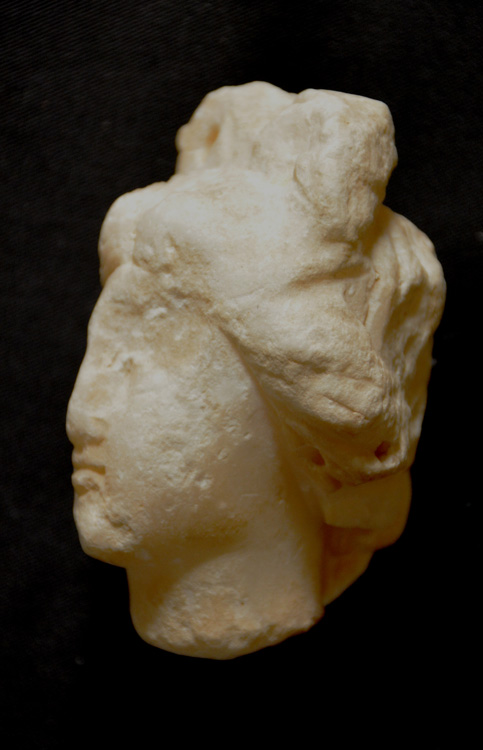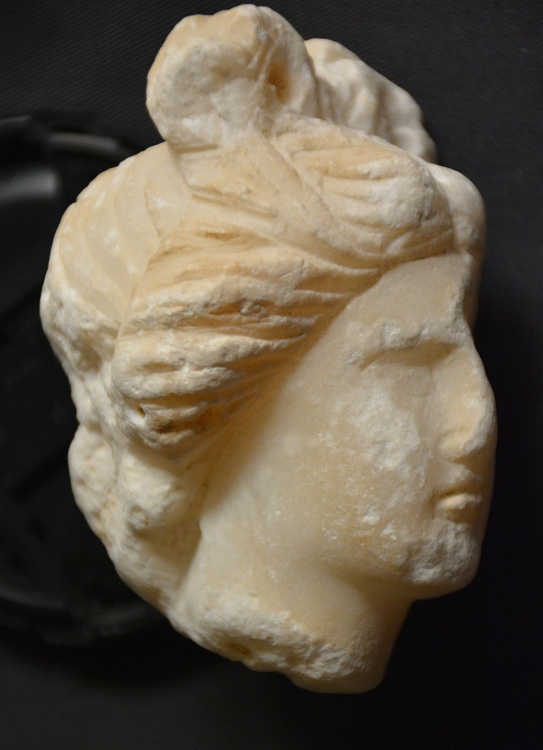Head of a statuette of Aphrodite (?)
Category
Gozo GroupAbout This Artefact
I.D. no: 32327
Dimensions: Max. H. 19 cm; Max. W. 16.5 cm
Material: Very fine-grain white marble
Provenance: Unknown
Current location: Museum of Archaeology, Gozo
Condition: Broken at the neck underneath which is a hole (probably modern, for display purposes). A series overlapping chips affect most of the hair mass at the back. Another relatively large chip has removed the left eye and temple. Minor abrasians on nose and various parts of facial and hair surfaces, removing the original, honey-coloured patina.
Description: The head probably belonged to a small statuette of Aphrodite wearing her typical complicated hairstyle. The latter is parted at the centre over the forehead and collected in a thick roll to frame the face, as well as a (now missing) knot over the nape at the back. At the level of the ear lobes, which are completely hidden by the hair, the framing hair rolls are pierced by two holes, one on each side, probably intended to carry earrings in metal. Two thick hair strands are also raised high to form two large upright knots on top of the head (forming a ‘corymbus’ or ‘krobylos’ of sorts), each one highlighted by a central deep hole, the left one of which has not survived. The surviving right eye is very summarily carved, showing only an empty socket.
Discussion: The head is a very modest copy, much reduced in size, of statues of a widely diffused type ultimately derived from a late-fourth-century BC creation headed by the Capitoline Aphrodite.[1] A number of such heads with slight variations on the same theme come from Cyrene.[2] Heads with similar hairstyles but different facial expression have also been attributed to Artemis. One such head, of a much larger size and finer quality, comes from the temple of Artemis at Cyrene.[3] Tentatively identified as Artemis is another head in the National Museum of Bucharest,[4] with which ours has a lot in common, especially in the facial features, the treatment of the hair and the facial expression. The Gozo head differs from all these heads in the attempted ‘sfumato’ treatment of the eyes which appear so evanescent as to be barely distinguishable. The exaggerated softness of the facial surfaces, especially in the eyes and mouth is, to some extent, akin to that of the ‘Maiden from Chios’.[5] The head could also be a greatly reduced version of one of the Aphrodite at the bath types that were very popular in the Hellenistic age, like the Capitoline Aphrodite mentioned above, the Kallipygos Aphrodite and the crouching Aphrodite created by Doedalsas. The closest version, at a much larger scale and immensely better quality, is the Bartlett Head in the Museum of Fine Art, Boston.[6]
Probably Roman of the first two centuries AD.
Bibliography: (previous publications of item): Unpublished.
[1] Bieber 1955 [revised ed. 1961]: 20, figs 34-35: a second century variation.
[2] Now in the British Museum: Huskinson 1975: 29-30, nos 56-58, pl.23, especially no 57 which has also preserved the fillet (or ‘taenia’) in front of the ‘corymbus’.
[3] Paribeni 1959: 68, no 153, pl. 89.
[4] Bordenache 1969: 43, no. 66, pl. 30.
[5] Comstock & Vermeule 1976: 40, no. 56.
[6] Comstock & Vermeule 1976: 39, no. 55, with previous bibliography. See also high quality views of head in:



